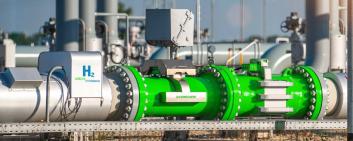Climate Risk Analytics
Climate-related disasters are becoming more frequent and more devastating. According to the Emergency Event Database, there were 432 climate-related hazards in 2021, compared to the twenty-year average of 357 annual catastrophe events. 2021 exceeded this number by over 20%, with a total economic cost of $16.5 billion. A recent report from SwissRe estimates that climate change could reduce the worldwide GDP by 10-18% by 2050 depending on global temperature rise in the coming years. These factors taken together – the increased frequency and cost of climate hazards over the past several years, demand for climate-risk transparency from investors and asset owners, and climate risk disclosure mandates coming into effect around the globe – are driving a scramble to develop tools for businesses to manage climate-related risks.
Climate risk analytics provide solutions to model, analyze, and report the impact of climate-related hazards on specific locations or assets through a combination of catastrophe and climate modelling, machine learning, and visualization technologies such as digital twin. Interest in space has peaked as mandatory disclosures, guided by the Taskforce on Climate-related Financial Disclosures (TCFD) recommendations, have come into effect in the UK [Companies Regulations 2022] and proposed regulation has been announced in the US [SEC proposal 2022]. There are several noteworthy trends, areas of innovation, and challenges taking place in the burgeoning sector:
- The insurance sector is not structured for the current level of climate-related economic and physical risk. Insurance and reinsurance companies such as Swiss Re are increasingly incorporating geographic climate risk factors into their service offerings and underwriting policies. Notable innovation is occurring in the creative application of climate risk analytics to niche markets and the layering of financial and socio-economic data onto climate risk data to provide customizable parametric insurance policies. Examples of such innovators include Descartes (France).
- Disclosure mandates regarding climate risk seem inevitable to spread around the world—the US, Singapore, Hong Kong, and New Zealand, among others, are on track to join France, Switzerland, and the UK in implementing mandatory disclosures in the near future. As corporates and financial institutions face looming regulation, they scramble to develop in-house capacity to evaluate their climate risk and impact or seek to outsource it to companies that provide compliance-specific services (for example Cervest in the UK). Examples of corporates acquiring climate risk analytics capabilities include S&P (acquired The Climate Service earlier this year) and the Demex Group´s (US) split from MunichRe.
As climate risk disclosure mandates come into effect across the globe, compatibility and standardization across national regulations will play an important role in the evolution of the sector. Incompatibility and dissonance could contribute to further fragmentation, create barriers to scaling innovative solutions, and solidify divisions between national markets. Cohesion and international standardization as well as compatibility with both TCFD recommendations and national emissions reductions goals could lay the foundation for comparable and meaningful risk disclosures, improved ESG ratings based on credible climate risk data, and facilitate international progress towards decarbonization.
Building Design Software
The building sector is a key area of focus for EU decarbonization goals, accounting for about 40% of energy consumption and 35% of emissions. In order to achieve carbon neutrality by 2050, and the shorter-term target of reducing emissions by 55% by 2030, significant action must be taken to improve the energy performance of existing assets and reduce the carbon footprint of new buildings. Conventional green building practices have focused on reducing the operational energy consumption and emissions of buildings. In recent years however the focus has shifted to the reduction of embodied carbon—associated with the materials and methods of construction—which can account for up to 50% of a building´s life-cycle emissions.
Efforts to reduce embodied carbon have previously centred around building materials such as low-carbon cement or upcycled wood. However, interest in supply-chain and project optimization coupled with technological advancements have resulted in key building design software innovations that allow architects and engineers to reduce carbon in the design and planning stages of a project as well as optimize building performance and end-of-life. Key trends include the following:
- The most commonly used design software in construction is Building Information Modelling (BIM), a software that allows for the collaborative creation of 3D model to facilitate the design, construction and operations management of buildings. Though currently a mainstay in the architecture, engineering and construction (AEC) industry, in recent years it has been leveraged in novel ways, notably through BIM-enabled Life Cycle Assessments (LCAs). BIM enabled LCAs model the lifetime carbon emissions of a building based on its design and material properties, allowing engineers and architects to compare different materials and structural design options to reduce the embodied carbon of the building. Additionally, LCA software provides credible data to demonstrate compliance with carbon budgets, mandatory LCA regulations, or apply for certifications.
- Digital Twin technology was first developed for spacecraft simulations but has since been adopted by a wide range of industries, including construction and infrastructure. Digital twins are a digital copy of a physical environment – incorporating real time data from the original – and in the case of construction, providing insight on performance, structural integrity, occupant use and health, along with predicting maintenance issues and weather disruptions. For example, Swiss innovator SwissInspect has developed digital twin software to optimize infrastructure use and predict failures and defects.
- Regulation plays a significant role in the usage and development of both BIM and LCAs. As of 2022, a growing number of European countries require the use of BIM for public projects, while in the UK certain levels of BIM maturity are mandated. The role of regulation as a driver is even more pronounced for the adoption of LCAs, where government mandates are the main driver. Switzerland, the UK and Germany have introduced LCA requirements for public buildings, and earlier this year LCAs became mandatory for all new buildings in France. Without LCA mandates, there is little incentive for AECs to commit to the traditionally complex and time-consuming process of LCA development although some early-adopters are utilizing LCA to reach specific corporate decarbonization goals.
While regulations are playing a key role in the adoption of sustainable design technologies, they are also a major barrier to widespread adoption and effectiveness in reaching sector-specific decarbonization goals. Inconsistency between national regulations, particularly across Europe, represent a significant challenge to software providers and significantly limit scaling potential. Very few innovators have been able to develop software that is compatible across certification systems and national regulations, with one exception being One Click LCA (Finland). AEC corporates and incumbents that take the initiative to lay the groundwork to incorporate LCAs across their business operations have the opportunity to prepare for future LCA requirements, comply with green building certifications and carbon budgets, and reduce the overall carbon footprint of their business operations.








